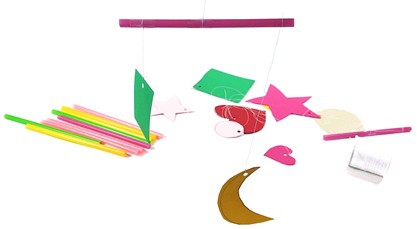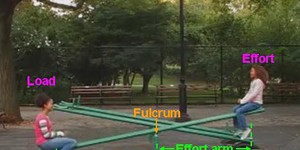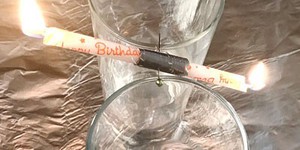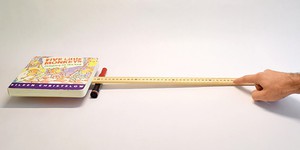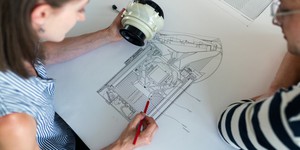Balance the Forces Within a Mobile
Summary
art mobile thumbnail
Introduction
Have you ever seen a mobile? Not a mobile phone, but a hanging art sculpture. You might have had such a mobile in your room when you were little. These mobiles hang from the ceiling and are usually made up of many layers of rods to which lots of differently shaped objects are attached with strings. When you look at the mobile sculpture, you might wonder how it can stay balanced all the time even when it is moving in the air. In this activity, you will make your own mobile sculpture and find out how it stays balanced.
Materials
- Heavy construction paper or cardstock, ideally various colors
- Hole punch
- Pen
- Markers
- Scissors
- Tape
- String
- Straws, at least 10
- Ceiling or door frame to hang the mobile from
- Optional: Scale with 0.1 g precision
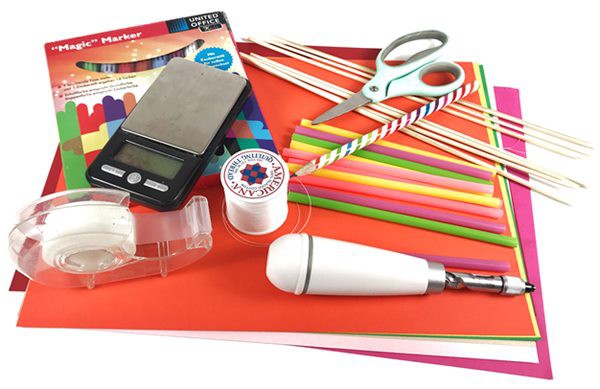 Image Credit: Svenja Lohner, Science Buddies / Science Buddies
Image Credit: Svenja Lohner, Science Buddies / Science Buddiesmaterials needed for this art mobile activity
Prep Work
- Draw 10 different shapes that you want to attach to your mobile on the construction paper. Ideally, the shapes should vary in shape and size.
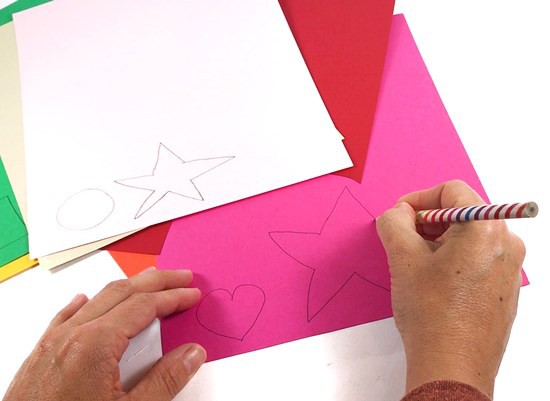 Image Credit: Svenja Lohner, Science Buddies / Science Buddies
Image Credit: Svenja Lohner, Science Buddies / Science Buddies
- Cut out the different shapes with your scissors. If you like, you can decorate each of them.
- Punch a hole into the top center of each of the cut-out shapes.
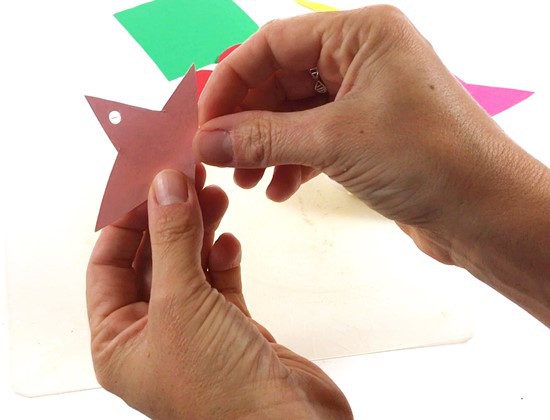 Image Credit: Svenja Lohner, Science Buddies / Science Buddies
Image Credit: Svenja Lohner, Science Buddies / Science Buddies
- Attach a piece of string to each of the shapes by threading it through the punched hole and tying a knot. Try to vary the length of string attached to each shape so that they are not all the same.
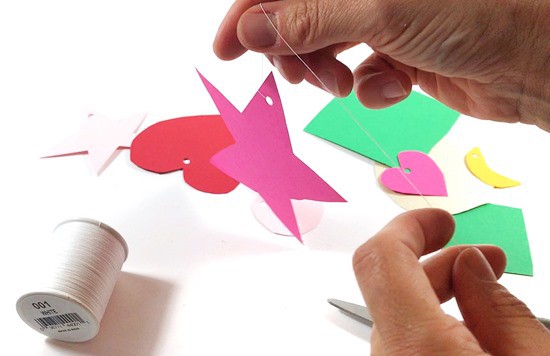 Image Credit: Svenja Lohner, Science Buddies / Science Buddies
Image Credit: Svenja Lohner, Science Buddies / Science Buddies
Instructions
- Start with one layer of your mobile. Attach a piece of string to the center of one of your straws. Hold the straw by the string so it is hanging freely in the air.Is the straw hanging horizontally? If not, what do you have to do to make it hang horizontally?
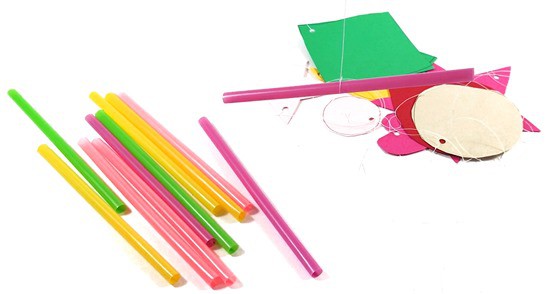 Image Credit: Svenja Lohner, Science Buddies / Science Buddies
Image Credit: Svenja Lohner, Science Buddies / Science Buddies
- Once the straw is balanced, tie your first shape to one end of the straw. Again, hold the straw up in the air by its string.What do you notice happens to the straw?
- Tie a second shape to the other end of the straw, then hold the straw up in the air again.Is the straw balanced? Why or why not?
- Balance the straw by moving one of the shapes along the straw.Can you find a position on the straw where both shapes are balanced?
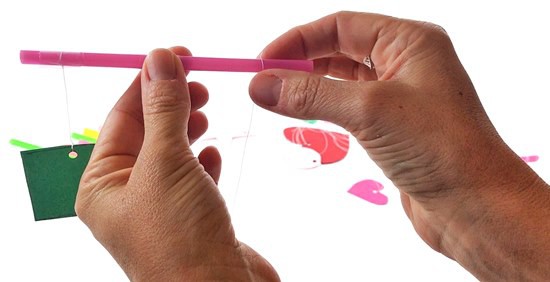 Image Credit: Svenja Lohner, Science Buddies / Science Buddies
Image Credit: Svenja Lohner, Science Buddies / Science Buddies
- Use a second straw and two more shapes to build another balanced structure.
- Repeat the previous step until you have used up all your cut-out shapes.
- Now, put all your pieces together to create a multi-layered mobile. Use strings to attach all the straws you made to one another until the mobile is balanced. You might want to use different lengths of string, so the shapes and straws are not bumping into each other.Are you able to balance all the forces within your mobile? How easy or difficult is it to balance all the pieces?
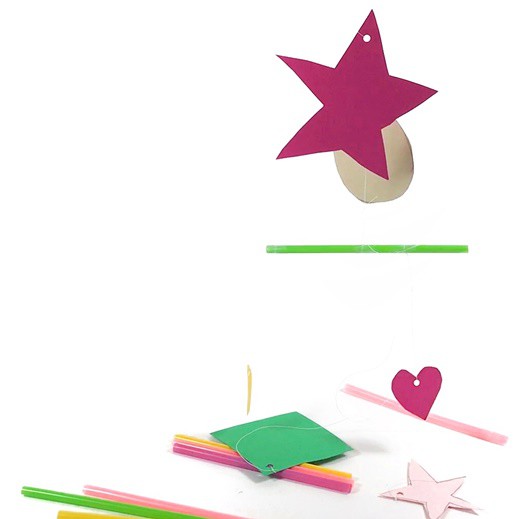 Image Credit: Svenja Lohner, Science Buddies / Science Buddies
Image Credit: Svenja Lohner, Science Buddies / Science Buddies
- Once you have successfully balanced your mobile, use tape or string to hang it from the ceiling or a door frame.When it hangs freely, does your mobile move?
- Carefully blow on one of the shapes hanging from the mobile.What do you observe?
Cleanup
- Clean up the remaining construction paper, string, and all your tools. You can hang the mobile up in your room or use it as a gift for a loved one.
What Happened?
Were you able to balance all the forces within your mobile? It might have been trickier than you thought. Even balancing a straw on a string can be challenging. You might have observed that if you did not attach the string to the very center of the straw, it was pulled down on one side more than on the other. To ensure that the straw hangs perfectly horizontal, the weight pulling down on each of its sides must be exactly the same (this is only true if the string is in the center of the straw). When you attached one shape to the straw, the weight of the shape should have pulled the straw down on the side it was attached to.
Attaching another shape to the other side of the straw most likely did not fully balance out the straw either. This was because the shape and size of both attached shapes were probably not exactly the same. The shape that was heavier pulled down on the straw more than the lighter shape. You were probably able to balance the straw out by moving the heavier shape closer to the pivot point (or center) of the straw. Based on the law of the lever, this should have reduced the force pulling on this side of the straw.
Putting the full mobile together probably took some patience. If you don't weigh all your objects, the mobile needs a lot of testing and trying to figure out how to balance the load on each of the straws. You might have noticed that the length of the string did not affect the balance of the straws very much, as the string itself is not very heavy. However, varying the string length throughout the mobile helps prevent objects from bumping into each other when it starts moving. When you hung up the mobile and blew on one of the shapes, it should have been obvious that the mobile moves pretty well even with the slightest breeze. The air movement pushed on the shape and, even though it was a small amount of force, the whole mobile started moving because all of its parts are connected!
Digging Deeper
Mobiles are free-hanging sculptures that are able to move in the air. These sculptures are not only very artistic, but they are also a perfect demonstration of balanced forces. If you look at a traditional mobile more closely you will usually notice that it is made of many different horizontal rods. On each end of these rods, there is an object attached with a string. When building a mobile, it is important to keep all the objects which are attached to one rod balanced so that the rod stays horizontal and is not pulled down in one direction. One single rod basically acts like a seesaw. If you put weight on one end of it, gravity will pull the rod down in that direction. To balance the rod, you need a counteracting force of the same magnitude on the other side.
However, it is not only the weight of the object that matters but also the location where it is attached to the rod. You might notice that not all of the objects are attached to the rod symmetrically, meaning that they are not equally spaced from the pivot point (or the center) of the rod. Even with two objects of the same mass, the rod can be moved in one direction by attaching one of the objects further away or closer to the rod's pivot point. In this case, the rotation of the rod is caused by the turning force, also called torque, which takes into account the force pulling down on the rod and the location of the applied force.
You might wonder why a free-hanging mobile is moving at all if all the forces are balanced within its structure. This is where Newton's first law of motion comes in. This law states that an object will not change its motion unless it is acted on by an external force. This means that a balanced mobile will be at rest as long as no additional forces are acting on its structure. So, what additional forces cause the mobile to move? The answer is that the air causes it to move. When air moves, it pushes on the objects hanging from the mobile. As a result, they start to move. This creates a ripple effect throughout the whole mobile structure because all of its pieces are connected. Thus, to balance out the external forces, the whole mobile structure moves until the forces acting on it are balanced out again.
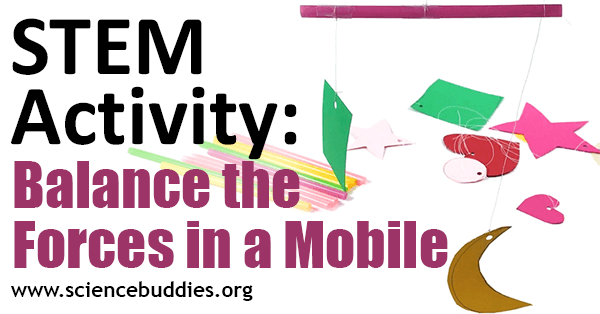 Image Credit: Science Buddies
Image Credit: Science Buddies
Ask an Expert
For Further Exploration
- You have used many strings to build your mobile and they were all different lengths. Find out if the length of the string that you use to attach your shapes to the straw matters. Make them both the same length and then two different lengths. Does it change how the straw is balanced?
- Instead of having two different shapes attached to one straw, have one shape on one side and another straw on the other side. Then add more shapes (or straws) to that straw. This is another way to add more layers to your mobile. How many layers can you build?
- Try to experiment with different lengths of straws. What changes if you cut one or more straws in half or use straws with different lengths throughout your mobile?
- Can you make a mobile using other materials, such as wooden blocks or other three-dimensional objects?
- If you want to make a really complex mobile, you can weigh each of your objects and use the law of the lever to calculate where each of your objects should be positioned on the straws. Draw your mobile structure on a piece of paper first and then write down the weights of each object that is attached to the straws. This will help you to find out how to best balance the forces in your mobile.
Related Resources
Project Ideas
Activities
Lesson Plans
- 3-5-ETS1-3. Plan and carry out fair tests in which variables are controlled and failure points are considered to identify aspects of a model or prototype that can be improved.


